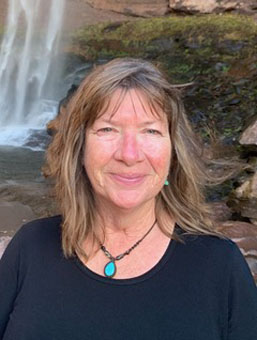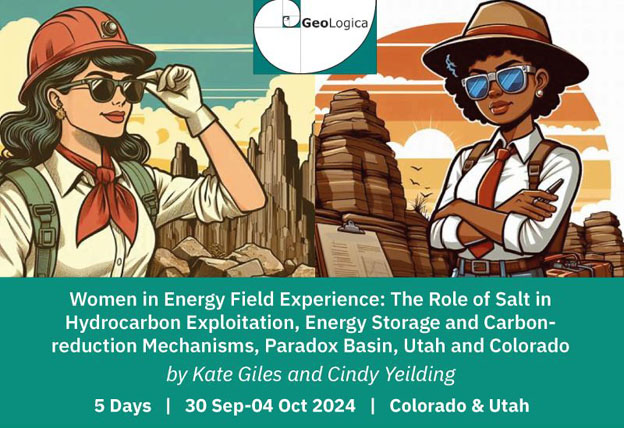
GeoLogica sat down for a chat with Kate Giles ahead of her upcoming field course: Women in Energy Field Experience: The Role of Salt in Hydrocarbon Exploitation, Energy Storage and Carbon-Reduction Mechanisms.
What is your field and specialization?
I’m a geoscientist specializing in sedimentology and stratigraphy and how they relate to tectonics. My background is primarily in carbonates, but I’ve worked siliciclastic systems as well. As for tectonics, I’ve worked a lot in both foreland and rift basins, but for the past 20 years I’ve been fascinated by all things related to salt tectonics.
Tell us a bit about your journey into teaching?
My training to be a teacher has basically been learning from watching others, starting as an undergrad at UW-Madison. I had some terrific, enthusiastic professors and grad students that were really inspiring and opened up a whole new world to me. This continued when I moved on to Iowa for my master’s and then Arizona for my PhD – just really terrific mentors and people. I took note of how they approached teaching and how they related their science to me, seeing what worked and what didn’t. Interestingly, in almost all of those cases, the teaching was field-based – I’ve found that physically seeing the relationships in the outcrop really brings it all together for me. So that’s how I like to approach teaching – by using field examples.
I started my career in the carbonate group at Exxon Production Research in Houston and, although I was in a research position, a significant part of my responsibility was teaching. The audience wasn’t just geologists, I was teaching the basic principles of carbonates and stratigraphy to engineers too. Their minds work a little differently, so it was really fun adapting my take on the science to a completely different audience.
After I left Exxon, I entered the academic realm, first at New Mexico State for 18 years and then UTEP for the past 12 years. I’ve taught at all levels – everything from highly focused technical work with PhD students, to trying to capture the interest of undergrad students who have never even thought about looking at a rock. So, it’s been a broad journey and I’ve really enjoyed relaying the science to everybody.
Tell us about a favorite memory from fieldwork or field training?
I have so many, but I’m going to tell you about one I had just over a week ago, and it’s probably the most incredible Zen moment of my whole life.
For more than 20 years, I’ve been going out to the Flinders Ranges of South Australia, doing field work on salt diapirs. A ridge of dolomite at a couple diapirs called the Rim Dolomite has been a thorn in my side from the beginning. We’ve interpreted it at least 500 different ways – we joke we’re working on hypothesis 627 now. There are a couple of issues with this bugger. Firstly, it has the whole ‘dolomite problem’ going on, but also the contacts above and below are always covered by talus from the ridge, so it’s hard to see what’s going on.
Last week we were finishing up in the field, it’s the last day and it had been raining for a couple of days and the ridge was completely covered in fog. We poked along on the talus slope looking for the outcrop one last time. At about 11:30am, the rain breaks, the sun starts to come out, and we hike to the ridge crest where we’re greeted with the most amazing view – sun rays in all directions bursting through the wall of clouds, down onto the rim dolomite ridge – casting it in the most amazing golden light. The birds start to come out and chirp; it’s sublime. Just then, I look down over the cliff and see there’s a drainage cutting across the rim dolomite and all of that talus has been stripped off. There is 100% exposure. For the first time, I can see this perfect inter-bedding of the rim dolomite and outboard mini-basin red siltstone. That little spot shreds our previous ideas on the area. To top it off, as we’re high-fiving in a total state of euphoria, the most beautiful iridescent blue-green little bird hops onto the contact and starts taking a bath in a puddle. It was just an incredible moment where everything in the universe came together in this one little spot.


Tell us about your upcoming course with GeoLogica – what is it about and who is it for?
This is a really exciting new course, which I’m delighted to be co-leading with Cindy Yielding. It’s designed to provide an opportunity for women to both learn and network out in nature. We’ve chosen to run it in the Paradox Basin of Utah and Colorado because of the exceptional exposures of salt diapirs and amazing scenery. It’s set up for women geoscientists and engineers at any level: those who want to gain some experience in looking at the fundamentals of salt tectonics, as well as those seeking high-level discussions about the intimate details of the structures. The main idea is to get out in the field to look at geologic relationships and consider how we might take these fundamental concepts and utilize them in a modern energy world.
Tell us a fun fact about yourself that most people don’t know.
I really love architectural design and gardens. I probably spend more time looking at them than actually doing geology! Geology allows me to go around the world and see architecture and gardens from all different cultures. The whole geology thing and field geology totally plays into that. And so, while I’m looking at the rocks, I’m also looking at the communities I’m going through – how they live, how they use the land, how they build their structures to tie into what they need it for. It’s really fun.
What is the biggest challenge facing the sector today from your perspective?
If I think of my sector as geoscience education, the biggest challenge is how universities need to evolve to meet the changing needs of our students and knowing where future geoscience careers are heading. We can’t even imagine all the new career options that will be available for students coming through now and in the future. We’re trying to develop curriculums that will help them be successful in these new career pathways, but we don’t have formal training in place for a lot of the topics they need. We’re scrambling now and I think the biggest challenge is the speed at which we’re trying to adjust. Obviously, the whole technological thing and being able to program and apply AI to the science is a really big deal, and so we’re changing our curriculum to be geared pretty heavily into those fields. I’m really worried, though, that we’re getting too far away from teaching the fundamentals of geoscience. But it’s so important for our students to come out suitably equipped to move on to these new careers and have the ability to adapt to future shifts – so that is a big challenge right now.
What would be your advice to junior geoscientists starting their careers today?
In short, keep learning. You come out of university with your degree, you start a career, you think you know what you’re going to be doing and you settle in. But you need to keep learning. Keep reading, taking classes, get out in the field and experiment with new stuff. Don’t be afraid of tackling things you think you’re bad at. Go learn about it, get good at it, or at least get to the point where you’re not afraid of it anymore. You want to set yourself up to be able to pivot because things are going to keep on changing. We don’t know for certain where things are going in the future, but we do know for certain, they will go fast. Also, as you’re moving forward, don’t lose sight of the fundamentals. Keep refreshing yourself on the basics and building on them.
Final question, can you give us your favorite geology joke?
I’m really bad at remembering any jokes, good or bad, but I do remember a pun from my structure TA as an undergrad:
‘All my faults are stress related.’

The Role of Salt in Hydrocarbon Exploitation, Energy Storage and Carbon-Reduction Mechanisms, Paradox Basin, Utah and Colorado
Date: 30 Sep - 4 Oct 2024
Type: Field
Discipline: Structural Geology
Tutor: Kate Giles, Professor Earth Sciences, University of Texas at El Paso and Cindy Yeilding, NE Director, Denbury Inc.
This course is aimed exclusively at women working in the energy industry, particularly in the geoscience, geotechnical and engineering fields. The primary technical goal is to provide a widely applicable introduction to the interrelationship between sedimentation and structural geology with a particular focus on salt tectonics and salt-sediment interaction. The geology is examined with reference to energy production, including hydrocarbon exploration and production, along with discussions around energy transition topics (CCUS, geothermal, hydrogen and energy storage). While the technical aspects are paramount, the course is also designed to provide networking and professional development opportunities. Evening discussions and activities will allow for exchange of ideas and experiences in a supportive and open atmosphere.
You will learn to:
- Describe the regional stratigraphy and principal structural features of the Paradox Basin, Utah.
- Characterize and interpret controls on Paradox Basin salt-related structures and key features of passive diapiric systems, including halokinetic sequences, caprock development, non-evaporite stringers / inclusions, welds, megaflaps, counter-regional faults, radial faults and burial wedges.
- Examine stratal geometries and halokinetic sequences and how these relate to intervals of salt inflation / evacuation and sediment flux.
- Assess the controls on basin fill architecture, fluid flow and deformation within the Paradox Basin and compare this to analogous salt basins worldwide.
- Understand the importance of salt basins to the energy industry for hydrocarbon production.
Level and Audience
Fundamental. This course requires a basic understanding of geoscience and will suit those working in the geoscience, geotechnical and engineering fields. The aim is to facilitate knowledge and experience exchange among the participants, so is open to women from a very wide range of experience levels.
KeyFacts Energy Industry Directory: GeoLogica l KeyFacts Energy news: Training
 KEYFACT Energy
KEYFACT Energy